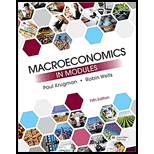
Concept Introduction:
Money Supply:
It refers to that amount of money which is in circulation within the economy at a particular point of time. It includes cash currency and all the liquid assets which can be converted into cash on
Increase in money supply and relation between public’s desire for holding currency and money multiplier.
Explanation of Solution
Given,
Public holds 50% in the form of currency.
New cash deposit is $500.
| Round | Deposits($) | Excess Reserves($) | Loans($) | Held as Currency($) | |
| 1 | 500 | 100 | 400 | 400 | 200 |
| 2 | 200 | 40 | 160 | 160 | 80 |
| 3 | 80 | 16 | 64 | 64 | 32 |
| 4 | 32 | 6.40 | 25.60 | 25.60 | 12.80 |
| 5 | 12.80 | 2.56 | 10.24 | 10.24 | 5.12 |
| 6 | 5.12 | 1.02 | 4.10 | 4.10 | 2.05 |
| 7 | 2.05 | 0.41 | 1.64 | 1.64 | 0.82 |
| 8 | 0.82 | 0.16 | 0.66 | 0.66 | 0.33 |
| 9 | 0.33 | 0.07 | 0.26 | 0.26 | 0.13 |
| 10 | 0.13 | 0.03 | 0.10 | 0.10 | 0.05 |
| Total | 833.25 | 166.65 | 666.60 | 666.60 | 333.30 |
| Table (1) |
| Round | Deposits($) | Required Reserves($) | Excess Reserves($) | Loans($) | Held as Currency($) |
| 1 | 500 | 100 | 400 | 400 | 200 |
| 2 | 200 | 40 | 160 | 160 | 80 |
| 3 | 80 | 16 | 64 | 64 | 32 |
| 4 | 32 | 6.40 | 25.60 | 25.60 | 12.80 |
| 5 | 12.80 | 2.56 | 10.24 | 10.24 | 5.12 |
| 6 | 5.12 | 1.02 | 4.10 | 4.10 | 2.05 |
| 7 | 2.05 | 0.41 | 1.64 | 1.64 | 0.82 |
| 8 | 0.82 | 0.16 | 0.66 | 0.66 | 0.33 |
| 9 | 0.33 | 0.07 | 0.26 | 0.26 | 0.13 |
| 10 | 0.13 | 0.03 | 0.10 | 0.10 | 0.05 |
| Total | 833.25 | 166.65 | 666.60 | 666.60 | 333.30 |
| Table (1) |
According to the calculated data, demand deposits have increased to $833.25 from $500, loan has increased to $666.60 from $400, and currency held by public has increased to $333.30 from $200.
If public does not hold any currency:
Formula to calculate increase in money supply,
Substitute $500 for initial deposit and 20% for reserve ratio.
Therefore, money supply will be increased to $2,000 and deposits in the bank will also increase to $2,500
Want to see more full solutions like this?
Chapter 14 Solutions
MACROECONOMICS IN MODULES
- Answerarrow_forwardM” method Given the following model, solve by the method of “M”. (see image)arrow_forwardAs indicated in the attached image, U.S. earnings for high- and low-skill workers as measured by educational attainment began diverging in the 1980s. The remaining questions in this problem set use the model for the labor market developed in class to walk through potential explanations for this trend. 1. Assume that there are just two types of workers, low- and high-skill. As a result, there are two labor markets: supply and demand for low-skill workers and supply and demand for high-skill workers. Using two carefully drawn labor-market figures, show that an increase in the demand for high skill workers can explain an increase in the relative wage of high-skill workers. 2. Using the same assumptions as in the previous question, use two carefully drawn labor-market figures to show that an increase in the supply of low-skill workers can explain an increase in the relative wage of high-skill workers.arrow_forward
- Published in 1980, the book Free to Choose discusses how economists Milton Friedman and Rose Friedman proposed a one-sided view of the benefits of a voucher system. However, there are other economists who disagree about the potential effects of a voucher system.arrow_forwardThe following diagram illustrates the demand and marginal revenue curves facing a monopoly in an industry with no economies or diseconomies of scale. In the short and long run, MC = ATC. a. Calculate the values of profit, consumer surplus, and deadweight loss, and illustrate these on the graph. b. Repeat the calculations in part a, but now assume the monopoly is able to practice perfect price discrimination.arrow_forwardThe projects under the 'Build, Build, Build' program: how these projects improve connectivity and ease of doing business in the Philippines?arrow_forward

 Principles of Economics (12th Edition)EconomicsISBN:9780134078779Author:Karl E. Case, Ray C. Fair, Sharon E. OsterPublisher:PEARSON
Principles of Economics (12th Edition)EconomicsISBN:9780134078779Author:Karl E. Case, Ray C. Fair, Sharon E. OsterPublisher:PEARSON Engineering Economy (17th Edition)EconomicsISBN:9780134870069Author:William G. Sullivan, Elin M. Wicks, C. Patrick KoellingPublisher:PEARSON
Engineering Economy (17th Edition)EconomicsISBN:9780134870069Author:William G. Sullivan, Elin M. Wicks, C. Patrick KoellingPublisher:PEARSON Principles of Economics (MindTap Course List)EconomicsISBN:9781305585126Author:N. Gregory MankiwPublisher:Cengage Learning
Principles of Economics (MindTap Course List)EconomicsISBN:9781305585126Author:N. Gregory MankiwPublisher:Cengage Learning Managerial Economics: A Problem Solving ApproachEconomicsISBN:9781337106665Author:Luke M. Froeb, Brian T. McCann, Michael R. Ward, Mike ShorPublisher:Cengage Learning
Managerial Economics: A Problem Solving ApproachEconomicsISBN:9781337106665Author:Luke M. Froeb, Brian T. McCann, Michael R. Ward, Mike ShorPublisher:Cengage Learning Managerial Economics & Business Strategy (Mcgraw-...EconomicsISBN:9781259290619Author:Michael Baye, Jeff PrincePublisher:McGraw-Hill Education
Managerial Economics & Business Strategy (Mcgraw-...EconomicsISBN:9781259290619Author:Michael Baye, Jeff PrincePublisher:McGraw-Hill Education





